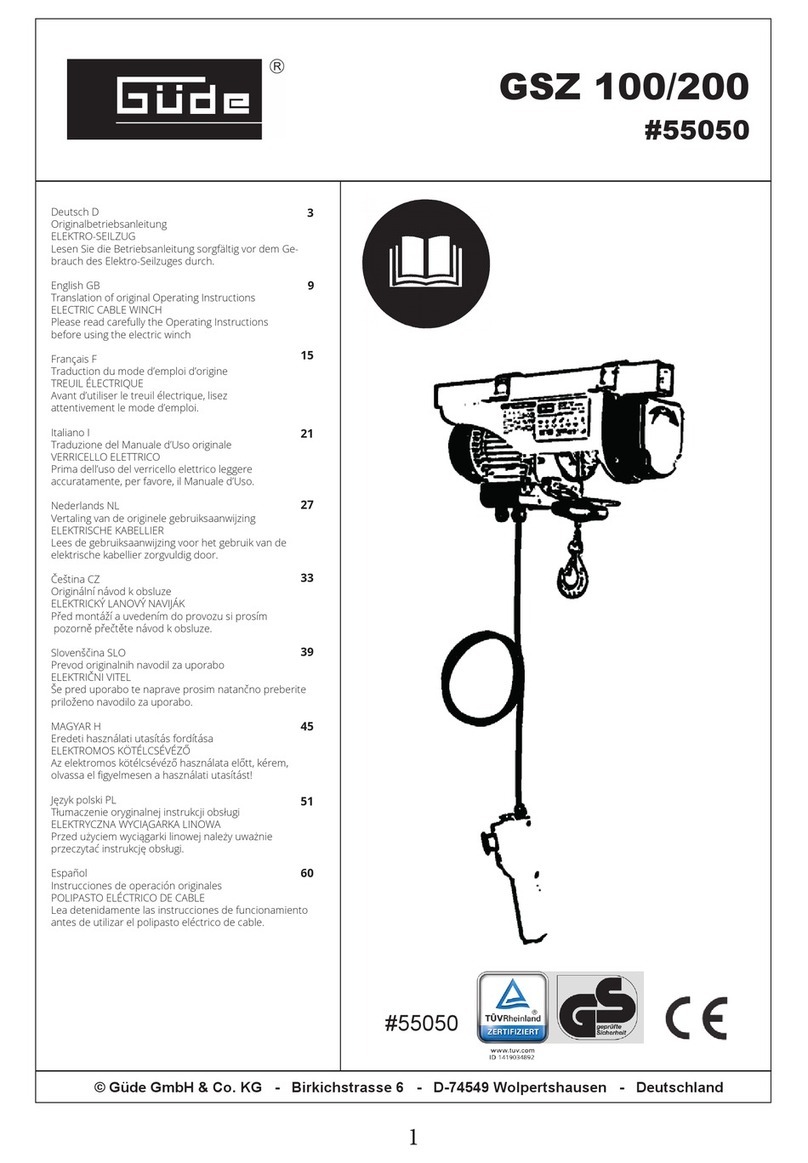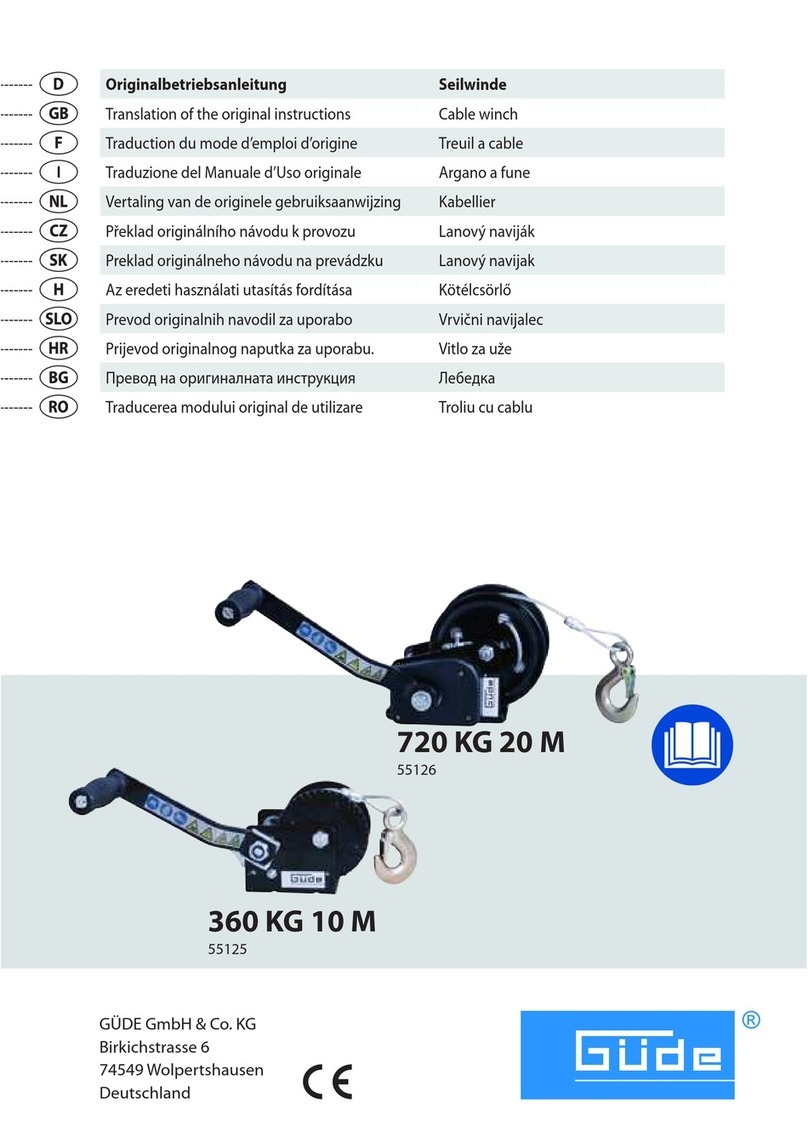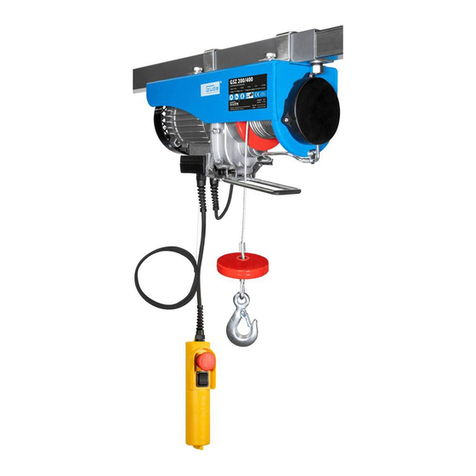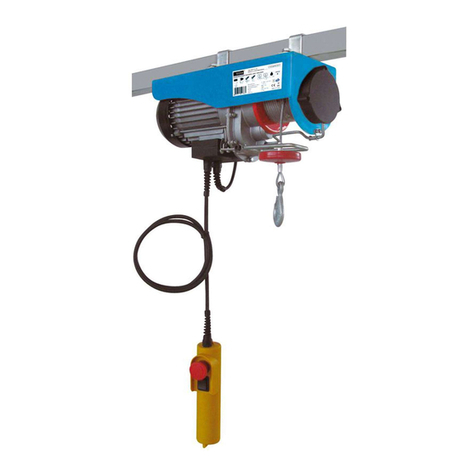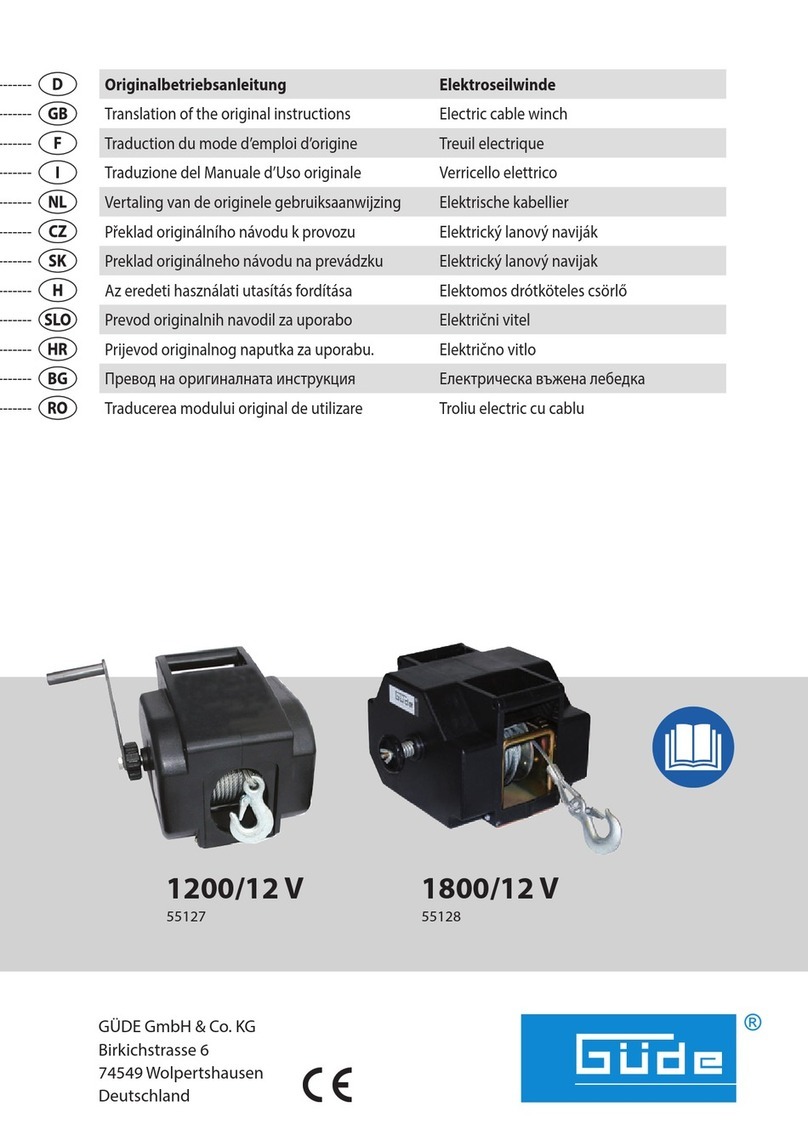
1,800/12V winch technical specifications
Max. pulling force 900 kg
Max. pulling force with idle pulley: 1,800 kg
Max. pulling force – floating items: 2,200 kg
Max. pulling force – travelling items: 2,700 kg
Protection type: IP 55
Protection class: 3
Connection: 12 V
Cable length: 9 m
Cable thickness Ø: 5.5 mm
Pulling speed: 1 m per minute
Drop-shaped opening in hook: 95 x 30 x 60
Mounting plate (attachment): 230 x 125 x
Overall dimensions LxWxH in mm: App. 270x295x200
Cable for remote control: 3 m
Electric cable: 3 m
Weight: 11 kg
Supply includes
Take the appliance out of the transport package and check
it whether there are the following parts:
•Utility cable with On/Off
•Electric cable with 2 grounding terminals
•9 m hauling rope with hook.
•Adapter plate for suspension equipment.
•Hand crank
•Idle pulley
•Operating Instructions
Please contact your dealer if any parts are missing or are
damaged.
Appliance description - pic. A-J
1. Hand crank
2. Cable winch body
3. Utility cable
4. On/Off
5. Utility cable connection
6. Lifting hook
7. Idle pulley
8. Electric cable
9. Adapter plate
10. Hand wheel
11. Utility cable connection outlet
12. Electric cable connection outlet
13. Terminal electric cable
14. Cable
Use as designated
The electrical cable winch is only suitable for pulling loads
stated in the technical specifications. The electric cable
winch must be mounted properly and may only be used
with 12 V battery appropriate for such work. The electric
cable winch is not suitable for lifting loads.
General safety instructions &preventive measures
CAUTION Please read all safety instructions and
directives. The failure to follow the safety instructions and
directives may result in electric shock, fire and/or serious
injuries.
Keep all safety instructions and directives for future
reference.
This appliance has not been designed to be operated by
persons (including children) with limited physical, sensory
or mental skills or insufficient experience and/or knowl-
edge, unless they work under the supervision of a safety
engineer and have received instructions from the engineer
on how to use the appliance.
Children must be supervised to make sure they do not play
with the appliance.
LEARN THOROUGHLY ALL INSTRUCTIONS BEFORE
USING THIS APPLIANCE!
•KEEP THE PLACE OF YOUR WORK CLEAN. Mess
in the place of work means a higher risk of injury.
•PROVIDE PROPER CONDITIONS IN THE PLACE
OF YOUR WORK. Do not use appliances in moist,
wet or poorly illuminated places. Do not expose the
appliance to rain. Provide adequate lighting of the
place of your work. Do not use electrically driven ap-
pliances near flammable gases or liquids.
•STORE ANY EQUIPMENT NOT BEING USED. If ap-
pliances are not being used, they must be stored in a
dry place to prevent them from corrosion. Store the
appliances in a lockable place at all times so that they
cannot be accessed by children.
•DO NOT OVERLOAD THE APPLIANCE. The appli-
ance works better and safer at the output for which it
has been designed. Trying to increase the appliance
performance using inappropriate extensions is prohib-
ited.
•USE THE RIGHT APPLIANCE FOR THE TASK TO
BE PERFORMED. The appliance must not be used
for purposes for which it has not been designed.
•WEAR APPROPRIATE CLOTHING. Do not wear
loose clothing or jewels as they could get caught by
the rotating parts. Wearing anti-slip shoes is recom-
mended. Long hair must be covered by appropriate
headwear. Appropriate working clothes need to be
worn at all times.
•USE EYE, HEARING AND BREATHING PROTEC-
TION EQUIPMENT. Glasses meeting statutory re-
quirements need to be worn for any works where turn-
ings or chippings are produced. A respirator or
breathing apparatus meeting statutory requirements
needs to be worn for works where metal dust, wood
dust, chemical dust and fog are produced. Appropri-
ate ear protectors need to be work for works in a
noisy environment.
•DO NOT USE THE ELECTRIC CABLE WINCH FOR
PURPOSES FOR WHICH IT HAS NOT BEEN DE-
SIGNED. Protect the electric cable against damage
as a result of mechanical influences, tension or cor-
roding agents. Do not pull the plug out of socket by
pulling the electric cable.
•DO NOT INCLINE ABOVE THE APPLIANCE. Make
always sure your posture is stable and balance kept.
Do not incline above the appliance when running.
•SERVICE THE APPLIANCES CAREFULLY. Appli-
ances must be kept clean at all times to work properly
and safely. Follow the lubrication instructions and ac-
cessory part changing instructions. Check the electric
cable at regular intervals and have it repaired by a
qualified expert if damaged. Check all rotating parts
and fixing bolts before using the appliance. The
switch handle and electric switch must be clean, dry
and with no oil and grease at all times.
•REMOVE ANY ADJUSTING WRENCHES. It is nec-
essary to make sure any wrenches and adjusting
tools are removed off the appliance or working sur-
face before starting your work.
•PREVENT UNATTENDED STARTING. Do not press
the switch before all the preparation for work initiation
is finished.
•DO NOT LOSE CONCENTRATION. Pay always at-
tention to what you are doing. Do not use the appli-
ance when you are tired.
•DO NOT USE THE APPLIANCE UNDER THE IN-
FLUENCE OF ALCOHOL, DRUGS OR PRE-
SCRIBED PHARMACEUTICALS.
•CHECK THE APPLIANCE FOR ANY DAMAGED
PARTS. All checks that seem to be damaged need to
be thoroughly checked before using the appliance to
make sure they work perfectly and meet their in-
tended purpose. In addition, it is necessary to check
whether the rotating parts are adjusted and fastened
properly, whether parts or fastening are not broken

